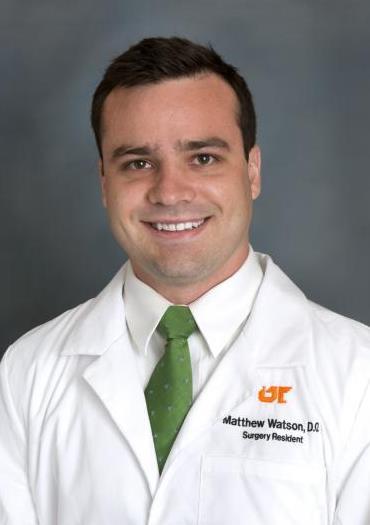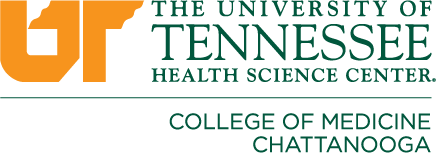Supervision and Procedures: Watson, Matthew (DO)
The Residency Supervision Area is designed to assist hospitals and clinics with the protocols outlined for specific duties residents and fellows can perform. These guidelines are determined by the faculty of the University of Tennessee College of Medicine Chattanooga, Department of Urology. Any questions about certain procedures not listed should be addressed to the faculty and not decided by the resident or fellow.
A credentialed and privileged attending physician ultimately provides supervision or oversight of each Resident's patient care activities. Direct supervision by a qualified attending physician (or a more senior Resident with Indirect Supervision immediately available) is required in the OR/Delivery Room or for non-routine invasive procedures like Cardiac Cath, Endoscopy, and Interventional Radiology.
- Click here to view our UTCOMC GME Policy 400 Resident Supervision
- Click here to view the UTCOMC GME Policy 405 Patient Care Settings Resident Supervision Standards

Mattew Watson, DO
PGY-4 Resident
Urology
Resident Supervision will consist of four categories/levels:
- Direct Supervision - the supervising physician is physically present with the resident and patient.
- Indirect Supervision with Direct Supervision IMMEDIATELY available - the supervising physician is physically within the hospital or other sites of patient care, and is IMMEDIATELY available to provide Direct Supervision.
- Indirect Supervision with Direct Supervision available - the supervising physician is not physically present within the hospital or other sites of patient care, but is IMMEDIATELY available by means of telephone or other electronic means, and can be available if required for Direct Supervision
- Oversight - Supervising Physician is available to provide a review of procedures or the encounter with feedback after the care is provided but the procedure or care does not warrant the physical presence of the attending.
- In particular, PGY-1 residents should be supervised either directly or indirectly with direct supervision immediately available as described in the levels of supervision, unless denoted as Oversight in the list that follows.
- In an emergency, defined as a situation where immediate care is necessary to preserve life or prevent serious impairment, residents are permitted to initiate whatever care is necessary and reasonable to save a patient from serious harm even if an attending physician is not immediately available to supervise. The appropriate Medical Staff member should be notified as soon as possible.
- Supervising physicians may be more advanced residents or fellows.
| Certifications current when the resident entered training at the UTCOMC. |
| Basic Life Support (BLS) |
| Advanced Cardiac Life Support (ACLS) |
| Advanced Trauma Life Support (ATLS) |
As a PGY-4 Level Urology Resident , the Resident is typically provided direct supervision by more senior residents or faculty unless performing skills and procedures listed below under Indirect or General Supervision -- with an attending physician or more senior resident immediately available. Residents are expected to progressively assume more responsibility throughout each level of training and demonstrate competence in skills/procedures requiring less Direct Supervision. The supervising physician may make adjustments in the level of supervision required for that specific procedure.
Patient Care Skills or Procedures that do not require Direct or Indirect Supervision presence of a supervising physician (i.e., Oversight/General Supervision) are listed below. Anything not specifically listed requires either Direct Supervision, Indirect Supervision with Direct Supervision Immediately Available, or Indirect Supervision with Direct Supervision available by phone or other electronic media, at the discretion of the supervising physician.
The Urology Residency is a five-year program.
PGY-1, PGY-2, PGY-3, PGY-4, and PGY-5 Urology Residents can perform the procedures
listed below with Indirect Supervision (with Direct Supervision immediately available):
PGY-1 and PGY-2 Urology Residents can perform the procedures listed below under Indirect Supervision or Oversight highlighted in red.
PGY-3 Urology Residents can perform the procedures listed below under Indirect Supervision or Oversight highlighted in green.
PGY-4 Urology Residents can perform the procedures listed below under Indirect Supervision or Oversight highlighted in blue.
PGY-5 Urology Chief Residents can perform the procedures listed below under Indirect Supervision or Oversight highlighted in orange.
| Differential Diagnosis, Treatment, Patient Care, and Procedural Skills | 1st and 2nd Year (PGY-1 and PGY-2) |
3rd Year (PGY-3) |
4th Year (PGY-4) |
5th Year Chief Resident (PGY-5) |
| Arterial Puncture | X | X | X | X |
| At-Home Call | X | X | X | X |
| Bedside cystoscopy as a non-operative procedure to assist with difficult Foley catheter placement and/or urethral dilation of urethral stricture disease | X | X | X | X |
| Bimanual and speculum pelvic exam | X | X | X | X |
| Biopsy (tissue) | X | X | X | X |
| Bladder catheterization (transurethrally and subrapubic) | X | X | X | X |
| Central venous pressue line | X | X | X | X |
| Chief Resident administrative and supervisory responsibilities | X | |||
| Clinic activities (urology - both oncology and non-oncology). Note: Pediatric urology clinic activities require Direct Supervision. | X | X | X | |
| Clinical and Social History | X | X | X | X |
| Communicate with patients and family members | X | X | X | X |
| Coordinate treatment with other disciplines | X | X | X | X |
| EKG - perform and interpret | X | X | X | X |
| Excision of subcutaneous or dermal lesion | X | X | X | X |
| Floor activities (urology - both oncology and non-oncology). Note: Pediatric urology floor activities require Direct Supervision. | X | X | X | X |
| Foley catheter placement or removal | X | X | X | X |
| Formulate diagnostic and treatment plans | X | X | X | X |
| Formulate pre-and post-operative treatment plans | X | X | X | X |
| Initial Emergency Department consults | X | X | X | X |
| Interpret basic x-rays and imaging studies | X | X | X | X |
| Intrepret all pre-op, intra-op, and post-op urologic imaging studies including KUB, IVP, bladder ultrasound, renal and scrotal ultrasound, cystogram, retrograde urethrogram, CT scan, and MRI (including trauma situations) | X | X | X | |
| Interpret laboratory and diagnostic studies and tests (including arterial blood gases) | X | X | X | X |
| Intravenous catheterization | X | X | X | X |
| Intravenous line | X | X | X | X |
| Knot tying | X | X | X | X |
| Mark surgical procedures on patients | X | X | X | X |
| Minor urologic surgical procedures (except Pediatric urology procedures which always require Direct Supervision) | X | X | X | |
| Nasotracheal intubation | X | X | X | X |
| Nephrostogram | X | X | X | X |
| Order radiologic, laboratory, or other diagnostic tests | X | X | X | X |
| Orotracheal intubation | X | X | X | X |
| Participate in and supervise a patient code | X | X | X | X |
| Participate in and supervise trauma patient care | X | X | X | X |
| Perform procedures in the OR with Indirect Supervision or Direct Supervision immediately available | X | X | ||
| Peritoneal lavage | X | X | X | X |
| Physical Examination | X | X | X | X |
| Request specialty and subspecialty consults | X | X | X | X |
| Retrograde Pyelogram | X | X | X | X |
| Roll with patient to surgery when staff is notified the attending is "on the way to the OR" | X | X | X | X |
| See patients and write patient orders | X | X | X | X |
| Stent placement | X | X | X | |
| Supervise Medical Students | X | X | X | X |
| Supervision more junior residents | X | X | X | X |
| Suprapubic tube placement | X | X | X | X |
| Suture simple wounds and lacerations | X | X | X | X |
| Swan Ganz catheterization | X | X | X | X |
| Thoracentesis | X | X | X | X |
| Transrectal ultrasound guided prostate biopsies with or without block (needle biopsy) | X | X | X | X |
| Triage adult and pediatric trauma patients | X | X | X | X |
| Tube thorocostomy | X | X | X | X |
| Urodynamics | X | X | X | X |
| Venipuncture | X | X | X | X |
| Wound care and debridement, including incision and drainage of scrotal wall abscesses or penile abscess and debridement | X | X | X | X |
| Write admission, treatment orders, and notes in the Electronic Health Record | X | X | X | X |
| Cardiopulmonary Resuscitation and Airway Maintenance | ||||
|
Perform Basic CPR and related procedures (airway management, emergency drug therapy, rhythm strip interpretation, intravenous catheterization, closed chest massage, electrocardioversion & defibrillation, and venous cut-down) |
X | X | X | X |
| Adult Resuscitation | X | X | X | X |
| All other procedures not listed should be performed under direct supervision of a faculty member or more senior resident. |


